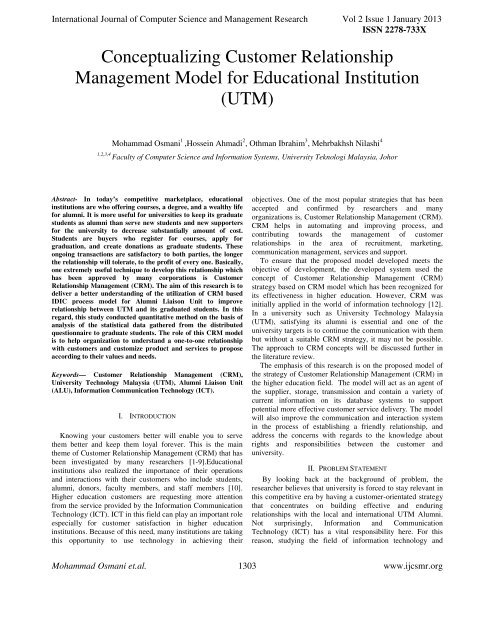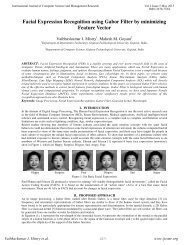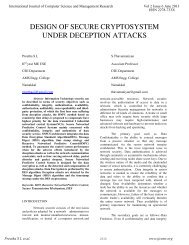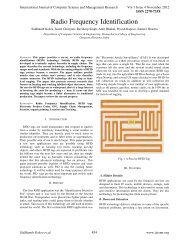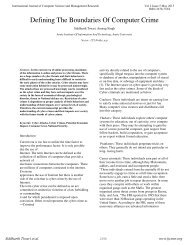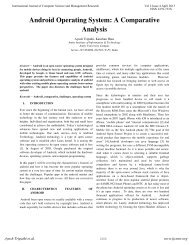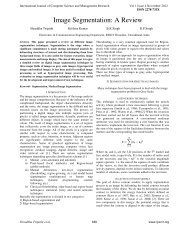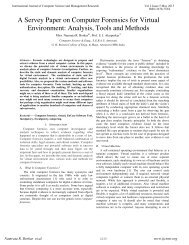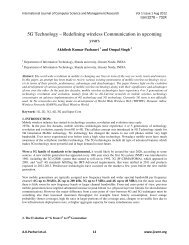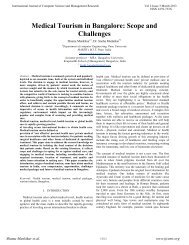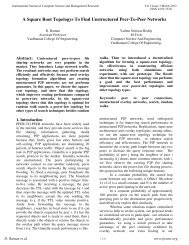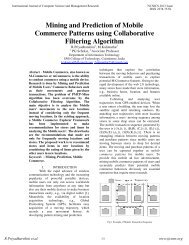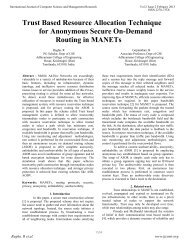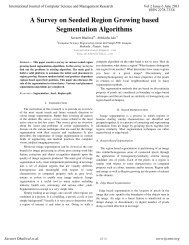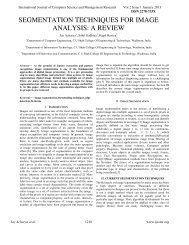Conceptualizing Customer Relationship Management Model ... - ijcsmr
Conceptualizing Customer Relationship Management Model ... - ijcsmr
Conceptualizing Customer Relationship Management Model ... - ijcsmr
Create successful ePaper yourself
Turn your PDF publications into a flip-book with our unique Google optimized e-Paper software.
International Journal of Computer Science and <strong>Management</strong> Research Vol 2 Issue 1 January 2013<br />
ISSN 2278-733X<br />
<strong>Conceptualizing</strong> <strong>Customer</strong> <strong>Relationship</strong><br />
<strong>Management</strong> <strong>Model</strong> for Educational Institution<br />
(UTM)<br />
Mohammad Osmani 1 ,Hossein Ahmadi 2 , Othman Ibrahim 3 , Mehrbakhsh Nilashi 4<br />
1,2,3,4<br />
Faculty of Computer Science and Information Systems, University Teknologi Malaysia, Johor<br />
Abstract- In today’s competitive marketplace, educational<br />
institutions are who offering courses, a degree, and a wealthy life<br />
for alumni. It is more useful for universities to keep its graduate<br />
students as alumni than serve new students and new supporters<br />
for the university to decrease substantially amount of cost.<br />
Students are buyers who register for courses, apply for<br />
graduation, and create donations as graduate students. These<br />
ongoing transactions are satisfactory to both parties, the longer<br />
the relationship will tolerate, to the profit of every one. Basically,<br />
one extremely useful technique to develop this relationship which<br />
has been approved by many corporations is <strong>Customer</strong><br />
<strong>Relationship</strong> <strong>Management</strong> (CRM). The aim of this research is to<br />
deliver a better understanding of the utilization of CRM based<br />
IDIC process model for Alumni Liaison Unit to improve<br />
relationship between UTM and its graduated students. In this<br />
regard, this study conducted quantitative method on the basis of<br />
analysis of the statistical data gathered from the distributed<br />
questionnaire to graduate students. The role of this CRM model<br />
is to help organization to understand a one-to-one relationship<br />
with customers and customize product and services to propose<br />
according to their values and needs.<br />
Keywords— <strong>Customer</strong> <strong>Relationship</strong> <strong>Management</strong> (CRM),<br />
University Technology Malaysia (UTM), Alumni Liaison Unit<br />
(ALU), Information Communication Technology (ICT).<br />
I. INTRODUCTION<br />
Knowing your customers better will enable you to serve<br />
them better and keep them loyal forever. This is the main<br />
theme of <strong>Customer</strong> <strong>Relationship</strong> <strong>Management</strong> (CRM) that has<br />
been investigated by many researchers [1-9].Educational<br />
institutions also realized the importance of their operations<br />
and interactions with their customers who include students,<br />
alumni, donors, faculty members, and staff members [10].<br />
Higher education customers are requesting more attention<br />
from the service provided by the Information Communication<br />
Technology (ICT). ICT in this field can play an important role<br />
especially for customer satisfaction in higher education<br />
institutions. Because of this need, many institutions are taking<br />
this opportunity to use technology in achieving their<br />
objectives. One of the most popular strategies that has been<br />
accepted and confirmed by researchers and many<br />
organizations is, <strong>Customer</strong> <strong>Relationship</strong> <strong>Management</strong> (CRM).<br />
CRM helps in automating and improving process, and<br />
contributing towards the management of customer<br />
relationships in the area of recruitment, marketing,<br />
communication management, services and support.<br />
To ensure that the proposed model developed meets the<br />
objective of development, the developed system used the<br />
concept of <strong>Customer</strong> <strong>Relationship</strong> <strong>Management</strong> (CRM)<br />
strategy based on CRM model which has been recognized for<br />
its effectiveness in higher education. However, CRM was<br />
initially applied in the world of information technology [12].<br />
In a university such as University Technology Malaysia<br />
(UTM), satisfying its alumni is essential and one of the<br />
university targets is to continue the communication with them<br />
but without a suitable CRM strategy, it may not be possible.<br />
The approach to CRM concepts will be discussed further in<br />
the literature review.<br />
The emphasis of this research is on the proposed model of<br />
the strategy of <strong>Customer</strong> <strong>Relationship</strong> <strong>Management</strong> (CRM) in<br />
the higher education field. The model will act as an agent of<br />
the supplier, storage, transmission and contain a variety of<br />
current information on its database systems to support<br />
potential more effective customer service delivery. The model<br />
will also improve the communication and interaction system<br />
in the process of establishing a friendly relationship, and<br />
address the concerns with regards to the knowledge about<br />
rights and responsibilities between the customer and<br />
university.<br />
II. PROBLEM STATEMENT<br />
By looking back at the background of problem, the<br />
researcher believes that university is forced to stay relevant in<br />
this competitive era by having a customer-orientated strategy<br />
that concentrates on building effective and enduring<br />
relationships with the local and international UTM Alumni.<br />
Not surprisingly, Information and Communication<br />
Technology (ICT) has a vital responsibility here. For this<br />
reason, studying the field of information technology and<br />
Mohammad Osmani et.al. 1303 www.<strong>ijcsmr</strong>.org
International Journal of Computer Science and <strong>Management</strong> Research Vol 2 Issue 1 January 2013<br />
ISSN 2278-733X<br />
management as well as the novelty of this area inspired the<br />
researcher to dissect this problem and look at it from the ICT<br />
position within the framework of business. Thus, the main<br />
the overall goals. The overall goal of this pyramid is to<br />
achieve customer satisfaction which will render a competitive<br />
advantage for an organization. Consequently, to improve<br />
problem identified was<br />
"How <strong>Customer</strong> <strong>Relationship</strong><br />
relationship between a customer and an organization, reaching<br />
<strong>Management</strong> <strong>Model</strong> can be cultivated in assisting Alumni<br />
Liaison Unit for improving relationship with UTM Alumni’’<br />
III. CUSTOMER<br />
The C in CRM stands for customer. The critical key is<br />
customer in CRM and this is especially necessary for service<br />
providing organizations such as the Alumni Liaison Unit.<br />
Nowadays, there are various terms used for customers, such as<br />
clients, users, s, purchasers, patrons, associates, subscribers and<br />
members. The important tip is that it should be according to<br />
nature of the organization and the nature of these names is<br />
varied. The issues at hand are: what is actually a customer<br />
Why is customer satisfaction action important to an organization<br />
Gaining insights about Alumni Liaison Unit and studying the<br />
responses of UTM Alumni responds are essentials questions.<br />
the pinnacle of this pyramid (customer satisfaction) is<br />
essential as there should be a good combination of elements of<br />
customer satisfaction related to <strong>Customer</strong> <strong>Relationship</strong><br />
<strong>Management</strong> (CRM).<br />
IV. THREE CRM PROCESS MODELS<br />
REVIEWS<br />
There is no precise definition for a <strong>Customer</strong><br />
<strong>Relationship</strong> <strong>Management</strong> strategy. Hence each corporation<br />
can have a specific meaning by its utilization of CRM towards<br />
particular goals. In Table 1 there are three different CRM<br />
process models which have been compared according to<br />
author and their understanding before selecting the most<br />
suitable of ones to be adapted d and enhanced based on the case<br />
study requirements.<br />
V. CASE STUDY APPROACH<br />
A. <strong>Customer</strong> Satisfaction<br />
Suitable CRM tools provide an easier mode for customers<br />
UTM Alumni Liaison Unit was chosen as case study in<br />
to do business with an organization through flexibility of self-<br />
order to find out relevant market segmentation or UTM<br />
service, ability to get what they need faster or getting target<br />
Alumni’s segmentation and also elements of UTM Alumni<br />
information that is immediately appropriate. Highly satisfied satisfaction for a good <strong>Customer</strong> relationship management<br />
customers tend to purchase more, cost less for the service, less<br />
(CRM) strategy implementation. The researcher has chosen<br />
price-sensitive and are glad to disseminate the global about the<br />
UTM Alumni Liaison Unit as the case for the preseason that:<br />
organization.<br />
Case studies are used when the researcher intends to support<br />
B. <strong>Customer</strong>-Centric Centric Strategies CRM Value Cycle (<strong>Customer</strong><br />
its own argument with an in-depth analysis of a person, group<br />
Satisfaction)<br />
of people, an organization or a particular project. As the<br />
nature of case study focuses on one aspect of a problem, the<br />
For organization to make a profit and achieve their ROI,<br />
conclusion drawn is not generalized but, rather related to one<br />
conditioned by customer satisfaction, customer loyalty should<br />
particular event. This is not to say that the case study approach<br />
flourish. <strong>Customer</strong> experience and interaction are the most<br />
is the limited value. On the contrary, it provides an in-depth<br />
important factors in a good customer relationship strategy,<br />
analysis of a specific problem. There are three types of case<br />
whereas data integration & analysis and marketing &<br />
study design: Exploratory case study, Explanatory cases study,<br />
communication are not very imperative to customers [11].<br />
and Descriptive cases study.<br />
It has been found that data integration and analysis,<br />
marketing and communication should not be simply for the<br />
C. Research Methodology<br />
purpose of CRM whereas customer experience is appearing to<br />
This research made utilization of framework as guidance<br />
be a very critical factor in order to satisfy the customer. Hence,<br />
for researcher, which is operational framework. This<br />
the aforementioned discussion has been enhanced by [11] as<br />
framework was run for implementing the whole steps taking<br />
in Figure 1.<br />
throughout this research project. Finally the conceptual<br />
framework which includes stages and information that is<br />
necessary to achieve the CRM strategy process.<br />
D. Operational Framework<br />
The operational framework has been provided containing<br />
each of the steps with clear explanation in how accomplish<br />
each phases of research. It also increases the understanding<br />
about the detail and implementing of the whole steps<br />
thoroughly.<br />
E. Questionnaire<br />
Figure 1.Pyramid Framework of a CRM Value Cycle [11]<br />
A questionnaire is a written list of questions, and the<br />
answers which are recorded by respondents. In a questionnaire<br />
There seems to be a need to develop customer-centric<br />
respondents read the questions, interpret what is expected and<br />
strategy which will assist the firm’s activities to accomplish<br />
Mohammad Osmani et.al.<br />
1304<br />
www.<strong>ijcsmr</strong>.org
International Journal of Computer Science and <strong>Management</strong> Research Vol 2 Issue 1 January 2013<br />
ISSN 2278-733X<br />
then write down the answers. One of the ways in which<br />
questionnaire can be administered is the emailed questionnaire;<br />
the most common approach to collecting information is to<br />
send the questionnaire to prospective respondents by email.<br />
Obviously, this approach presupposes that you have access to<br />
their addresses. Questionnaire contained series of questions<br />
which delivered to number of respondents. In this study, 100<br />
questionnaires have been distributed to UTM Alumni. 60 of<br />
the questionnaires were returned to the researcher while other<br />
is still pending to be returned. The aim of these questionnaires<br />
is to understand their perception and potential needs towards<br />
Alumni Liaison Unit. Another purpose is to find out the<br />
current and prospective relationship between alumni and UTM,<br />
and find satisfaction of the service (include ALU information<br />
on the website, ALU medium of communication and ALU<br />
interaction with members) that is provided by UTM to alumni.<br />
questionnaires were returned back to the researcher while<br />
others did not respond. Among the respondents (61.7%), were<br />
international alumni, while the rest meaning that (38.3%),<br />
were local alumni. Table 2, shows the detail of this survey.<br />
Valid<br />
Table 2.<br />
Frequency %<br />
UTM Alumni Type<br />
Valid<br />
%<br />
Cumulative<br />
%<br />
International<br />
alumni<br />
37 61.7 61.7 61.7<br />
Local alumni 23 38.3 38.3 100.0<br />
Total 60 100 100.0<br />
Table 1.<br />
Comparison between the CRM Process <strong>Model</strong>s<br />
CRM Mover/<br />
Authors<br />
Elements of <strong>Model</strong> Process Phases Objectives of <strong>Model</strong><br />
CRM Adoption <strong>Model</strong> [14]<br />
CRM Process <strong>Model</strong> [13]<br />
IDIC Process <strong>Model</strong> [2]<br />
-<strong>Relationship</strong> marketing,<br />
-Appropriate organizational<br />
structure,<br />
-Data Initialization,<br />
-leverage of data warehouse,<br />
-Developing customer strategy,<br />
-Set customer objectives,<br />
-Assess organization readiness,<br />
-Align organization behind<br />
goals,<br />
-Execute CRM,<br />
-Measure program effectiveness,<br />
-Identification,<br />
-Differentiation,<br />
-Customization,<br />
-Interaction,<br />
Consist of four<br />
phases<br />
Consist of Six<br />
phases<br />
Consist of Four<br />
phases<br />
<strong>Relationship</strong> making for<br />
CRM<br />
Automation process<br />
services and<br />
consultation<br />
Achieve customers’<br />
satisfaction and loyalty<br />
through establishing longterm<br />
relationship<br />
VI. THE QUESTIONNAIRE FINDING<br />
Questionnaire were set to find out the kind of current and<br />
prospective relationship between Alumni Liaison Unit and its<br />
members, alumni’s segmentation to improve alumni’s needs<br />
and elements of UTM Alumni satisfaction related to CRM.<br />
100 questionnaires were distributed to UTM Alumni from<br />
various places as respondents. 60 of these questionnaires were<br />
returned back to the researcher while others did not respond.<br />
Among the respondents (61.7%), were international alumni,<br />
while the rest meaning that (38.3%), were local alumni. Table<br />
2, shows the detail of this survey.<br />
Questionnaire were set to find out the kind of<br />
current and prospective relationship between Alumni Liaison<br />
Unit and its members, alumni’s segmentation to improve<br />
alumni’s needs and elements of UTM Alumni satisfaction<br />
related to CRM. 100 questionnaires were distributed to UTM<br />
Alumni from various places as respondents. 60 of these<br />
Analysis from the questionnaire in this survey (Table 3)<br />
demonstrated that about (28.33%) of respondents are still in<br />
touch with UTM Alumni Liaison Unit, whereas the others<br />
(71.67%) that returned, showed that they are not in touch with<br />
UTM Alumni Liaison Unit.<br />
Valid<br />
Table 3 . UTM Current <strong>Relationship</strong> with alumni<br />
Frequency<br />
Q7PartA<br />
Percent<br />
Valid<br />
Percent<br />
No 43 71.7 71.7 71.7<br />
Yes 17 28.3 28.3 100.0<br />
Total 60 100.0 100.0<br />
Cumulative<br />
Percent<br />
Mohammad Osmani et.al. 1305 www.<strong>ijcsmr</strong>.org
International Journal of Computer Science and <strong>Management</strong> Research Vol 2 Issue 1 January 2013<br />
ISSN 2278-733X<br />
As it can be seen in (Table 4), in this survey the majority of<br />
participants are undergraduate with (63.3%), while the<br />
participants for postgraduate are (36.7%).<br />
Valid<br />
Table 4 . Kind of UTM Alumni<br />
Frequency<br />
Precent<br />
Valid (%)<br />
Cumulative (%)<br />
Postgraduate 22 36.7 36.7 36.7<br />
Undergraduat<br />
e<br />
38 63.3 63.3 100<br />
Total 60 100 100.0<br />
F. Suggestion for Alumni Liaison Unit Medium of<br />
Communication<br />
Based on the result of the questionnaire from respondents<br />
(Table 5), most of the percentages (35%) of alumni members<br />
offered that Alumni Liaison Unit medium of communication<br />
should be based on website. The (28.33%) agreed with email<br />
as the second suggestion for medium of communication. The<br />
(16.67%) of respondents wanted face book, (11.67%) agreed<br />
with the post, while the minority of the respondents (8.33%)<br />
suggested call center as the medium of communication for<br />
Alumni Liaison Unit. By observing the result of this<br />
questionnaire the researcher can conclude that Alumni Liaison<br />
Unit for improving the relationship with its members and<br />
increase their satisfaction should add more effort on CRM<br />
strategy towards the adaptation of its behavior on website as<br />
the medium of communication.<br />
Table 5 .Suggestion for ALU Medium of Communication<br />
Frequency<br />
%<br />
Valid %<br />
Cumulative<br />
%<br />
members. (23.33%) of respondents agreed and (18.33%)<br />
preferred to state of neutral. On the other side (15%) disagreed<br />
and (8.33%) strongly disagreed to suggest for Alumni Liaison<br />
Unit to provide services based on alumni’s requirement. This<br />
can be concluded by the researcher that the majority has<br />
agreed for the customization of service. Therefore Alumni<br />
Liaison Unit should give a consideration on this issue of<br />
customization of service that they give to alumni members.<br />
Valid<br />
Table 6 .<br />
Need for Customization towards Service<br />
Frequency<br />
%<br />
Valid %<br />
Cumulative %<br />
Agree 14 23.3 23.3 23.3<br />
Disagree 9 15 15.0 38.3<br />
Neutral 11 18.3 18.3 56.7<br />
Strongly Agree 21 35 35.0 91.7<br />
Strongly<br />
Disagree<br />
5 8.3 8.3 100.0<br />
Total 60 100.0 100.0<br />
H. Need for Interaction based on Alumni’s Requirement<br />
From the result which shows in Table 7 (43.33%) of the<br />
alumni members agreed with the suggestion of Alumni<br />
Liaison Unit should use CRM strategy for interacting with<br />
alumni members with respect to their requirements toward the<br />
Alumni organization. The (23.33%) of respondents preferred<br />
to state of neutral and (13.33%) strongly agreed, whereas<br />
(11.67%) and (8.33%) are respectively disagreed and strongly<br />
disagreed who said no to the suggestion. Conclusion from the<br />
researcher based on the result presented that Alumni Liaison<br />
Unit should use CRM strategy for special interaction with<br />
their members in respect to their requirements toward the<br />
Alumni organization.<br />
Table 7. Need for Interaction<br />
Valid<br />
Call Center 5 8.3 8.3 8.3<br />
Email 17 28.3 28.3 36.7<br />
Face book 10 16.7 16.7 53.3<br />
Post 7 11.7 11.7 65.0<br />
Website 21 35.0 35.0 100.0<br />
Total 60 100.0 100.0<br />
G. Need for Customization towards Service based on<br />
Alumni’s Requirement<br />
Table 6, shows that (35%) of alumni members<br />
strongly agreed to suggest that Alumni organization should<br />
deliver their services based on alumni’s requirements which is<br />
based on the differentiation of different level of alumni<br />
Valid<br />
Cumulative<br />
%<br />
Valid %<br />
%<br />
Frequency<br />
Agree 26 43.3 43.3 43.3<br />
Disagree 7 11.7 11.7 55.0<br />
Neutral 14 23.3 23.3 78.3<br />
Strongly Agree 8 13.3 13.3 91.7<br />
Strongly Disagree 5 8.3 8.3 100.0<br />
Total 60 100.0 100.0<br />
Mohammad Osmani et.al. 1306 www.<strong>ijcsmr</strong>.org
International Journal of Computer Science and <strong>Management</strong> Research Vol 2 Issue 1 January 2013<br />
ISSN 2278-733X<br />
VII. MODEL DESIGN<br />
The model designed bases on CRM lifecycle as illustrated<br />
in Figure 1 which adapted from [11]. The model which<br />
consists of four phases, further enhanced with more steps and<br />
detail steps for each Phase; as it can be seen in Figure 2, Phase<br />
1 is to identify the alumni member’s requirements. This let<br />
alumni to feel that organization know them and betters the<br />
relationship that in between them. Phase 2 is differentiation<br />
which divided into, differentiation by value and by<br />
requirements. Phase 3 is the customization based on member’s<br />
value and requirements. Phase 4 is where organization<br />
delivers the benefit to these targeted members, is the<br />
Interaction phase. It also consists of two phases, alumni<br />
interaction by their value and by their requirements<br />
throughout the implementation of CRM strategy model.<br />
Literature review and analysis phase of research as<br />
described in Chapter two early. The model designed bases on<br />
CRM lifecycle as illustrated in Figure 1 which adapted from<br />
[11]. The model which consists of four phases, further<br />
enhanced with more steps and detail steps for each Phase; as it<br />
can be seen in Figure 2, Phase 1 is to identify the alumni<br />
member’s requirements. This let alumni to feel that<br />
organization know them and betters the relationship that in<br />
between them. Phase 2 is differentiation which divided into,<br />
differentiation by value and by requirements. Phase 3 is the<br />
customization based on member’s value and requirements.<br />
Phase 4 is where organization delivers the benefit to these<br />
targeted members, is the Interaction phase. It also consists of<br />
two phases, alumni interaction by their value and by their<br />
requirements throughout the implementation of CRM strategy<br />
model.<br />
Figure 2.<br />
New CRM Strategy <strong>Model</strong><br />
VIII.<br />
CONCLUSION<br />
there already exit a path or form of university-company<br />
collaboration. With this path and agreement in place, UTM<br />
Alumni can get easy access to organizations.<br />
Based on the constraints and challenges the researcher<br />
encountered when carrying out this thesis, the researcher<br />
seeks to recommend that the faculty or institution through its<br />
Research and Development unit liaises with various<br />
companies located within the city where the institution is<br />
situated. So that will be easy for UTM Alumni mainly the<br />
international alumni to get across the organizations because<br />
Mohammad Osmani et.al. 1307 www.<strong>ijcsmr</strong>.org
International Journal of Computer Science and <strong>Management</strong> Research Vol 2 Issue 1 January 2013<br />
ISSN 2278-733X<br />
REFERENCES<br />
[13] Kincaid, J. W., (2003). <strong>Customer</strong> <strong>Relationship</strong><br />
<strong>Management</strong>: Getting It Right, Hewlett-Packard<br />
[1] J. Dyche, The CRM Handbook: A Business Guide<br />
Company.<br />
to Cusomer <strong>Relationship</strong> <strong>Management</strong>: Addison- [14] Reinartz, Werner and V. Kumar (2003), “The<br />
Wesley, 2002.<br />
Impact of <strong>Customer</strong> <strong>Relationship</strong> Characteristics<br />
[2] M. J. Tarokh and H. Ghahremanloo, "Intelligence<br />
on Profitable Lifetime Duration”, Journal of<br />
CRM: A Contact Center <strong>Model</strong>," in Service<br />
Marketing, 67 (January),<br />
Operations and Logistics, and Informatics,2007.<br />
SOLI 2007. IEEE International Conference on,<br />
2007, pp. 1-6.<br />
[3] T. S. H. Teo, P. Devadoss, and S. L. Pan,<br />
"Towards a holistic perspective of customer<br />
relationship management (CRM) implementation:<br />
A case study of the Housing and Development<br />
Board, Singapore," Decision Support Systems, vol.<br />
42, pp. 1613-1627, 2006.<br />
[4] A. Keramati, N. Mojir, and H. Mehrabi,<br />
"Prioritizing Investment in CRM Resources to<br />
Improve Performance: An Empirical<br />
Investigation," in Information <strong>Management</strong> and<br />
Engineering, 2009. ICIME '09. International<br />
Conference on, 2009, pp. 330-334.<br />
[5] A. S. Lo, L .D. Stalcup, and M. A. Lee, "<strong>Customer</strong><br />
<strong>Relationship</strong> <strong>Management</strong> for Hotels in Hong<br />
Kong," International Journal of Contemporary<br />
Hospitality <strong>Management</strong>, vol. 22, 2009.<br />
[6] [J.-M. Moutot and G. Bascoul, "Effects of Sales<br />
Force Automation Use on Sales Force Activities<br />
and <strong>Customer</strong> <strong>Relationship</strong> <strong>Management</strong><br />
Processes," Journal of Personal Selling & Sales<br />
<strong>Management</strong>, vol. 28,pp. 167-184, 2008.<br />
[7] E. J. Ragins and A. J. Greco, "<strong>Customer</strong><br />
<strong>Relationship</strong> <strong>Management</strong> and E-Business: More<br />
Than a Software Solution," Review of Business,<br />
vol. 24, p. 25, Winter2003 2003.<br />
[8] E. J. Ragins and A. J. Greco, "<strong>Customer</strong><br />
<strong>Relationship</strong> <strong>Management</strong> and E-Business: More<br />
Than a Software Solution," Review of Business,<br />
vol. 24, p. 25, 2003.<br />
[9] W. Reinartz, M. Krafft, and W. D. Hoyer, "The<br />
<strong>Customer</strong> <strong>Relationship</strong> <strong>Management</strong> Process: Its<br />
Measurement and Impact on Performance,"<br />
Journal of Marketing Research (JMR), vol. 41, pp.<br />
293-305, 2004.<br />
[10] Richard N. Katz (2002), <strong>Customer</strong> <strong>Relationship</strong><br />
<strong>Management</strong> : Web Portal and Higher Education<br />
Technologies to make IT Personal, Jossey-Bass<br />
Inc.<br />
[11] Siddiqi. J. Babak. A. Wise. T. 2002. “A<br />
framework for implementation of a <strong>Customer</strong><br />
relationship management strategy in retail sector”.<br />
Sheffield Hallam University (UK).<br />
[12] Randy Harris (2003). What is <strong>Customer</strong><br />
<strong>Relationship</strong> <strong>Management</strong> (CRM) System United<br />
States: Darwin Magazine. Retrieved May 8, 2003.<br />
Mohammad Osmani et.al. 1308 www.<strong>ijcsmr</strong>.org


